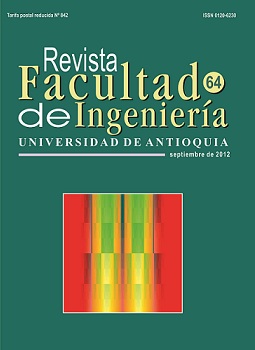Using fracture energy to characterize the hot mix asphalt cracking resistance based on the directtensile test
DOI:
https://doi.org/10.17533/udea.redin.13121Keywords:
cracking resistance, direct tensile test, tensile strength, fracture energy, hot mix asphalt (HMA)Abstract
Cracking is currently one of the most common distresses in hot mix asphalt (HMA) pavements, often costing the highway agencies million of dollars in maintenance and rehabilitation activities. Laboratory characterization of HMA cracking resistance thus constitutes a fundamental step in mix-design and analysis to ensure adequate Æ eld performance in terms of this distress. This study assesses the suitability of analyzing the HMA cracking resistance using fracture parameters determined based on the direct tension test, which include the fracture energy. Corresponding results suggest that the fracture energy and the proposed fracture energy indices has promising potential to be used as fracture parameters to discriminate the cracking resistance potential of HMA mixes in the laboratory. More research is recommended to further reÆ ning this concept and relate to Æ eld cracking resistance data.
Downloads
References
Y. Huang. Pavement Analysis and Design. Ed. Pearson, Prentice Hall. Upper Saddle River. N. J. USA. 2004. pp. 34, 488.
A. Tayebali, A. Deacon, S. Coplantz, T. Harvey, L. Monismith. Fatigue Response of Asphalt Aggregate Mixes. Report SHRP A-003. Strategic Highway Research Program, National Research Council. Washington D. C. 1992. pp. 62-63.
L. Walubita, V. Umashankar, X. Hu, B. Jamison, F. Zhou, T. Scullion, A. Epps, S. Dessouky. New Generation Mix-Designs: Laboratory Testing and Construction of the APT Test Sections. Report 0-6132-1. Texas Transportation Institute-Texas A&M University. College Station, TX. USA. 2010. pp. 2-3.
K. Ghuzlan, S. Carpenter. Traditional Fatigue Analysis of Asphalt Concrete Mixtures. TRB 82nd Annual Meeting, Washington D.C. 2003. pp. 1-26.
L. Walubita, G. Simate, J. Oh. “Characterising the Ductility and Fatigue Crack Resistance Potential of Asphalt Mixes Based on the Laboratory Direct Tensile Strength Test”. Journal of the South African Institution of Civil Engineering. Vol. 52. 2010. pp. 31-40.
MathWorks. MATLAB. “Math Works”. Natick. Massachusetts. USA. 2011.
F. Walubita, T. Scullion. Thin HMA Overlays in Texas: Mix-Design and Laboratory Material Property Characterization. Research Report No 0-5598-1. Texas Transportation Institute-Texas A&M University. College Station, TX. USA. 2008. pp. 4-1 a 7-13.
TxDOT. TxDOT - Online Manuals. Disponible en: http://www.dot.state.tx.us/services/general_services/manuals.htm. Consultado el 13 de julio de 2011.
E. Alvarez, A. Epps, C. Estakhri, J. Button, Z. Kraus, N. Prapaitrakul, C. Glover. Evaluation and Recommended Improvements for Mix Design of Permeable Friction Courses. Report No FHWA/TX-08/0-5262-3. Texas Transportation Institute-Texas A&M University. College Station, TX. USA. 2008. pp. 2.
TxDOT. Standard SpeciÆ cations for Construction and Maintenance of Highways, Streets, and Bridges. Austin. TX. 2004. pp. 265-329.
L. Walubita, B. Jamison, A. Alvarez, T. Scullion. “Air Void Characterization of Hot Mix Asphalt Gyratory Laboratory-Molded Samples and Field Cores Using X-Ray Computed Tomography (X-Ray CT)”. Journal of the South African Institution of Civil Engineering. Vol. 54. 2012. pp. 22-31.
A. Alvarez, A. Epps, C. Estakhri. “Internal Structure of Compacted Permeable Friction Course Mixtures”. Construction and Building Materials. Vol. 24. 2010. pp. 1027-1035. DOI: https://doi.org/10.1016/j.conbuildmat.2009.11.015
A. Alvarez, A. Epps, C. Estakhri. “A Review of Mix Design and Evaluation Research for Permeable Friction Course Mixtures”. Construction and Building Materials. Vol. 25. 2011. pp. 1159-1166. DOI: https://doi.org/10.1016/j.conbuildmat.2010.09.038
A. Alvarez, A. Epps-Martin, C. Estakhri. “Optimizing the Design of Permeable Friction Course Mixtures”. Transportation Research Record. Vol. 2209. 2011. pp. 26-33. DOI: https://doi.org/10.3141/2209-04
Downloads
Published
How to Cite
Issue
Section
License
Copyright (c) 2018 Revista Facultad de Ingeniería

This work is licensed under a Creative Commons Attribution-NonCommercial-ShareAlike 4.0 International License.
Revista Facultad de Ingeniería, Universidad de Antioquia is licensed under the Creative Commons Attribution BY-NC-SA 4.0 license. https://creativecommons.org/licenses/by-nc-sa/4.0/deed.en
You are free to:
Share — copy and redistribute the material in any medium or format
Adapt — remix, transform, and build upon the material
Under the following terms:
Attribution — You must give appropriate credit, provide a link to the license, and indicate if changes were made. You may do so in any reasonable manner, but not in any way that suggests the licensor endorses you or your use.
NonCommercial — You may not use the material for commercial purposes.
ShareAlike — If you remix, transform, or build upon the material, you must distribute your contributions under the same license as the original.
The material published in the journal can be distributed, copied and exhibited by third parties if the respective credits are given to the journal. No commercial benefit can be obtained and derivative works must be under the same license terms as the original work.










 Twitter
Twitter